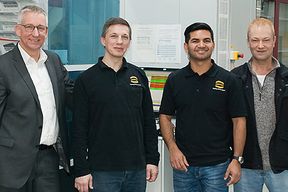“We have specialised in the design, development and production of sophisticated injection moulding moulds, punching and bending tools and special machinery as well as micro-technology manufacturing processes”, explains Managing Director Dr. Volker Franke, who is responsible for the tool making that is extremely important for HARTING - amalgamated in HARTING Applied Technologies GmbH. The term high-tech does not only apply to the products in Espelkamp, but also to the tool making. After all, the company is one of the most modern of its kind, and has already been recognised as ‘Toolmaker of the Year’ on three occasions (2014, 2016 and 2018).
HARTING had already established itself at a relatively high level in the area of milling, but there was still significant room for improvement, particularly in the area of hard machining. This particularly applied to the desire for shorter processing times, but should not be achieved at the cost of a shorter service life under any circumstances. At this point, even the cost-effectiveness of the entire project of replacing the grinding of valves by milling was in doubt. The Westphalian company’s own attempts in this area had been fruitless. They therefore contacted MMC Hitachi Tool. After all, the process optimisers of the Japanese tool manufacturer collaborate closely with customers on working out more efficient processing strategies.
After the analysis of the current situation which is obligatory at MMC Hitachi Tool, the initial general tests were soon carried out. These were so promising that the company wanted to transfer the knowledge into everyday business. A valve with similar geometry but different dimensions and constitutes the volume business at HARTING during hard processing, so to speak, was selected for this purpose. These valves had been ground in the past. Far in excess of 20 identical valves of this kind are used in multi-cavity moulds. These are used to inject the plastic levers which act as a locking mechanism for the well-known, modular Han connector. This valve is made from thermal wear-resistant plastic mould steel X38CrMoV5-1 (1.2343). After roughing, it is pre-hardened to 52 to 54 HRC and the surfaces semi-finished from 0.2 mm to 0.02 mm and then finished to the final dimensions. The tolerance specification for these surfaces is between 0 mm and -0.01 mm in the overall dimensions.
First the feasibility was analysed. Different tools and cutting values were tried out together, machining times, wear behaviour and surfaces were compared, and it was checked time and time again whether improvements were possible. Starting with different ball cutters and other types of milling cutter, they finally arrived at the EHHR milling cutter, which was also tried out in different diameters. A test workpiece with a diameter of 8 mm quickly proved to be ideal.
The result surpassed all of the previous tests by far. The EHHR (Epoch High Hard Radius) is a 6-bladed VHM cutter that is designed exclusively for hard machining and has a slightly polygonal design manufactured by MMC Hitachi Tool, which has an in-house ATH coating system. The diameter of the side cutters, which are offset by 120 degrees, is slightly tapered compared to the end cutters, resulting in a high material removal rate and a long tool life at the same time. In conjunction with the six blades of the tool, this results in high feed rates and therefore very short machining times. The fast cutting speeds that were achieved in Espelkamp with the EHHR were impressive: With bigger parts, where a diameter of 12 mm was used, speeds of up to 350 m / min were achieved for pre-finishing, even in excess of 500 m / min for final finishing.
A total of just 2 EHHR cutters with a diameter of 8 mm - one for semi-finishing, the other for finishing - had finally been sufficient for machining a complete set of valves to the final dimensions. And this was carried out extremely quickly and with top quality surfaces. Even after the last valve, the tool had so little wear that it was still well within tolerance. It would have been possible to mill even more valves before the EHHR went out of tolerance. But that was not tested.
The EHHR is currently used with diameters of 6, 8 and 12 mm in the toolmaking shop at HARTING because of the different components. In this way, all of the current valve types are manufactured automatically in accordance with this sample that has been jointly developed by HARTING and MMC Hitachi Tool. The proven production strategy will also be used for forthcoming projects in Espelkamp and will be declared the manufacturing standard. HARTING Applied Technologies now obtains more than 80 percent of its milling tool requirements in the hard milling area from the Japanese toolmaker. As well as the quality of the tools, the process development expertise of MMC Hitachi Tool is crucial, and is becoming increasingly important to the company from Westphalia.
As part of the 'Production 50' manufacturing concept developed specially for tool and mould construction by MMC Hitachi Tool, a cost-effectiveness calculation was carried out for the test valve at the conclusion of the project, which is based on values for previous surface grinding and documents and compares the costs exactly on the basis of the new milling processes. Result: A cost saving of 60 percent has been achieved by using milling rather than surface grinding. "There are also the significantly reduced throughput times, the elimination of manufacturing bottlenecks when grinding and the additional flexibility achieved by the changeover to milling. We have now made the breakthrough in automated hard milling, "says a delighted Dr. Volker Franke. "We have achieved exactly what we wanted to with regard to parallelism, angularity, wear and process reliability. In terms of the surfaces and tolerances, we have even surpassed the specifications, also in comparison to grinding. "
Contact:
Mr Hauke Steinigeweg
MMC Hitachi Tool Engineering Europe GmbH
Itterpark 12
40724 Hilden
Tel. +49 (0) 21 03 - 24 82-0


